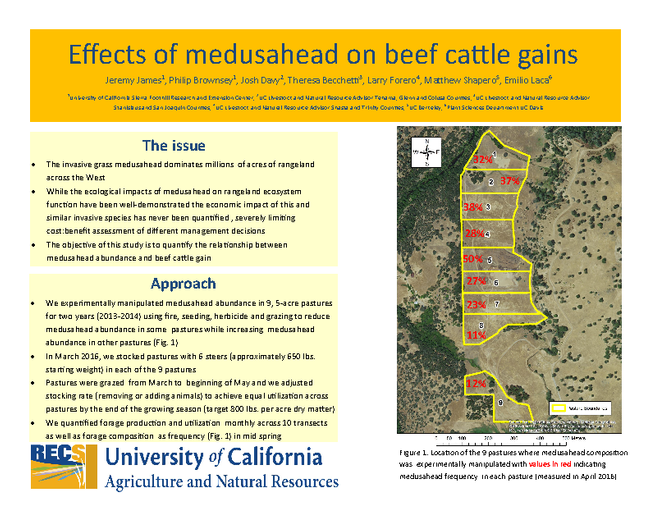Here is a short summary written by Theresa Becchetti, University of California Cooperative Extension (UCCE) Livestock and Natural Resource Advisor on the Effects of Medusahead on Beef Cattle Gains project.
*******************
Livestock and Natural Resource Advisors, Specialists, and faculty have been researching Medusahead (an invasive grass with lower grazing quality) for many years now. We know it reduces carrying capacity on rangelands, creates a thatch that can become a fire hazard, and reduces the diversity of plants on rangelands to the extreme monoculture of Medusahead in some locations. We have also found many different management options to control Medusahead, all varying in costs, amount of effort required, and level of control. With seeds living in the seedbank up to three years, a plan of attack needs to be made, with more than a one-time treatment applied. Current research that is just completing at the Sierra Foothill Research and Extension Center provides a look at the cost of Medusahead invading rangelands and is summarized here.
Unlike other projects where we selected a control option (or two) and applied it to the existing Medusahead cover, this project manipulated the amount of Medusahead, in some cases planting more Medusahead to achieve the desirable percent of cover for each pasture. Prior to the grazing portion of the project, the amount of Medusahead cover was either reduced by using grazing, fire, seeding, or herbicides or Medusahead was seeded to increase the percent cover. The pastures ranged in the percent of Medusahead from 11% up to 50%, levels that are pretty representative of most rangelands in our area.
A year after Medusahead cover targets were reached, each of the 5 acres pastures were stocked with six (6) steers, each steer weighing about 650lbs. Pastures were grazed from March to May and stocking rate was adjusted so equal utilization was reached in each pasture, with a target of 800 lbs/acre of dry matter left.
While average daily gains were not affected by the percent of Medusahead, ADG was highest in March than April (4.2lbs/animal/day compared to 3.1lbs/animal/day). Typically quality is better on annual grasses in March, prior to grasses setting seeds, so this make sense, even with Medusahead at higher levels. In the vegetative stage we know from previous work that Medusahead is still palatable and has similar crude protein levels as more desirable grasses. However, stocking rate was found to be negatively affected by Medusahead. The more Medusahead in the pasture, the lower the stocking rate. We found on average for every 10% increase in Medusahead, there is a decrease in gains over 30lb/acre over the grazing season. To calculate a dollar value, we used the price 800-900lb steers were selling for at time of shipping, which was $1.19. Using this value, for every 10% decrease in Medusahead, there could be an associated $38 more per acre market value. Most of the treatment cost on a per acre basis will be that or less, making it pencil to control Medusahead on your ranch if you are able to take advantage of the increase in carrying capacity.
If you have any questions about Medusahead control on your ranch, please give me a call so we can talk about your particular ranch and what management options might work better for you and your operation.
Theresa Becchetti, Livestock and Natural Resource Advisor
Stanislaus and San Joaquin counties
*******************
For more information on the project, see http://sfrec.ucanr.edu/files/243208.pdf. The following people worked on the project: Jeremy James1 (lead), Philip Brownsey1, Josh Davy2, Theresa Becchetti3, Larry Forero4, Matthew Shapero5, and Emilio Laca6
1UC ANR Sierra Foothill Research and Extension Center, 2UCCE Livestock and Natural Resource Advisor Tehama, Glenn and Colusa counties, 3UCCE Livestock and Natural Resource Advisor Stanislaus and San Joaquin counties, 4UCCE Livestock and Natural Resource Advisor Shasta and Trinity counties, 5UCCE Livestock and Range Advisor Ventura and Santa Barbara counties, 6UC Davis, Dept. of Plant Sciences
Attached Files: